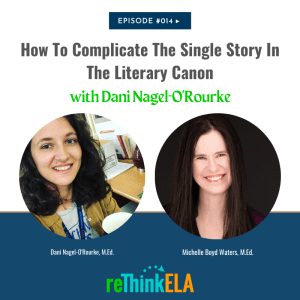
 Teachers around the United States are finding themselves on the frontlines of a cultural battle that has heated up significantly in recent months. Book banning and legislation that seeks to prevent teachers from doing their actual jobs have taken to new levels the historical battles between conscientious English Language Arts teachers and institutions within the system that do not serve students.
Teachers around the United States are finding themselves on the frontlines of a cultural battle that has heated up significantly in recent months. Book banning and legislation that seeks to prevent teachers from doing their actual jobs have taken to new levels the historical battles between conscientious English Language Arts teachers and institutions within the system that do not serve students.
It’s been a minute (as our students would say) since I’ve published an episode of this podcast, but recent changes in my career have afforded me more time and fortitude to confront these issues directly. In this episode, I am honored to interview Dani Nagel-O’Rourke who is the English department chair at an Oklahoma suburban high school. She is also an alumni of the University of Oklahoma, where we took graduate classes together in the Instructional Leadership and Academic Curriculum program. She agreed to discuss strategies that you can use in your classroom to honor the letter of the law while still providing your students with access to literature that represents American society.
Of course, as teachers, and readers of history, we know the books facing the burn pile are frequently the ones that represent our actual student populations across the country. I see this in my own experience as a student at the University of Oklahoma. I walk to class with students from a diverse cultural and racial backgrounds. I attend class with students (and a professor) from four different countries. (That may be five depending on how you define “from.”) This was true in the suburban schools I taught in, as well.
While the student populations in rural schools where I served were significantly less diverse, the students in those schools also needed mirrors, windows, and sliding glass doors, as described by Dr. Rudine Sims Bishop.
It seems the few books left untouched this year are the ones written by dead white (mostly) men more than 50 years ago. These books are effectively the only ones available in many schools because they were the only ones with class sets on the library shelves and the library couldn’t afford to replace them. Or didn’t want to.
So what do we do? Listen as Dani shares her strategies for complicating — not replacing — the canon.
Resources from this episode
- Bishop, R. S. (1990). Mirrors, windows, and sliding glass doors. Perspectives, 6(3), ix–xi.
- 100+ Novels Every High School Student Should (Consider) Read(ing)
- How To Honor All Students During Tough Classroom Discussions
- Advocacy: When Students & Teachers Resist Learning About Racism
Essential Question: How do you complicate the literary canon in your classroom?

So thankful for the time spent discussing the canon with you! We could have talked for hours on the topic, we were enjoying the exchange of ideas! Sad we missed the opportunity to discuss the four types of curriculum and how the canon seeds into that, but there are other days!